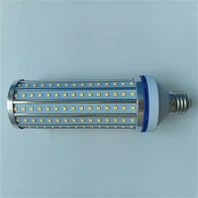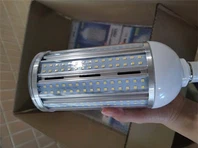LED Corn Light Bulb vs. Traditional High-Pressure Sodium Lamps: Energy Savings and Lifespan Comparison
For decades, high-pressure sodium (HPS) lamps have been the go-to lighting solution for industrial and commercial spaces like warehouses, high-bay factories, and outdoor parking lots. Their ability to produce high lumen output at a relatively low initial cost made them a practical choice for large, tall areas requiring widespread illumination. However, as energy efficiency and long-term cost savings become top priorities for facility managers, LED corn light bulbs have emerged as a formidable alternative. Named for their cylindrical shape and rows of LED chips, these modern fixtures outperform HPS lamps in two critical areas: energy consumption and lifespan. This article compares LED corn light bulbs and traditional HPS lamps head-to-head, focusing on how their differences in energy efficiency translate to cost savings and how their lifespan gaps reduce maintenance burdens-ultimately helping businesses make informed decisions about their lighting upgrades.
Energy Efficiency: The Core Cost-Saving Divide
Energy efficiency is where LED corn light bulbs and HPS lamps differ most dramatically, and this gap directly impacts a facility's operational expenses. HPS lamps operate on an outdated technology: they use an electric arc to heat sodium vapor, producing light. This process is inherently inefficient, as only 20–30% of the electrical energy is converted into usable light- the remaining 70–80% is wasted as heat. LED corn lights, by contrast, leverage semiconductor technology to emit light directly, converting up to 90% of energy into illumination. This fundamental difference results in drastic energy savings for businesses that switch to LED.
To quantify this, consider a 100,000-square-foot warehouse with 100 high-bay lighting fixtures. A typical 250W HPS lamp produces approximately 22,000 lumens-enough to illuminate a large section of the warehouse. To match this lumen output, a LED corn light bulb only requires 100W of power. At an average industrial electricity rate of $0.15 per kWh, and with lights operating 12 hours a day, 365 days a year, the energy cost difference is striking:
HPS Lamp Cost: A 250W HPS lamp uses 0.25 kWh per hour. For 12 hours daily, that's 3 kWh per day, or 1,095 kWh per year per fixture. For 100 fixtures, total annual energy consumption is 109,500 kWh, costing $16,425.
LED Corn Light Cost: A 100W LED corn light uses 0.1 kWh per hour. For 12 hours daily, that's 1.2 kWh per day, or 438 kWh per year per fixture. For 100 fixtures, total annual energy consumption is 43,800 kWh, costing $6,570.
This translates to an annual energy savings of \(9,855- a 60% reduction in lighting-related electricity bills. For facilities operating 24/7 (e.g., 24-hour distribution centers), the savings are even more substantial: annual costs drop from \)32,850 (HPS) to \(13,140 (LED), a savings of \)19,710 per year. Over five years, the total energy savings for a 100-fixture warehouse exceed $49,000- a figure that far outweighs the higher upfront cost of LED corn lights.
Another hidden energy cost of HPS lamps is heat management. The excess heat they produce forces HVAC systems to work harder to cool the facility, especially in warm climates or during summer months. This secondary energy drain adds 5–10% to a facility's overall cooling costs. LED corn lights produce minimal heat, reducing the strain on HVAC systems and delivering additional savings that HPS lamps cannot match.
Lifespan: Reducing Maintenance and Downtime
Lifespan is the second critical area where LED corn light bulbs outshine HPS lamps. The lifespan of a lighting fixture is typically measured by its L70 rating- the number of hours until its brightness drops to 70% of its initial output (the point at which most facilities replace bulbs). HPS lamps have a relatively short L70 rating, ranging from 10,000 to 24,000 hours. At 12 hours of daily use, this translates to a lifespan of 2–6 years. LED corn lights, by contrast, have an L70 rating of 50,000 to 100,000 hours- equivalent to 11–22 years of service at 12 hours per day. This fivefold difference in lifespan revolutionizes maintenance practices for industrial facilities.
The short lifespan of HPS lamps creates a cycle of frequent replacements, which is costly and disruptive. Replacing HPS bulbs in high-bay spaces requires specialized equipment like scissor lifts or cherry pickers, and each replacement costs \(50–\)100 in labor alone (not including the cost of the bulb itself). For a 100-fixture warehouse, replacing HPS bulbs every 4 years (a midpoint in their lifespan) means 25 replacements per year- totaling \(2,500 in annual labor costs, plus \)1,000 for new HPS bulbs (at \(40 per bulb). Over 10 years, this adds up to \)35,000 in maintenance expenses.
LED corn lights eliminate most of this burden. With a 15-year lifespan (a conservative estimate for high-quality models), a 100-fixture warehouse would only need to replace bulbs once every 15 years. Over 10 years, this reduces maintenance labor costs to just \(667 (for a single partial replacement cycle) and bulb costs to \)667- a total of $1,334, or 96% less than HPS maintenance costs. Additionally, fewer replacements mean less downtime for the facility. Replacing HPS bulbs often requires pausing operations in the affected area, which can slow down productivity for hours. LED corn lights' long lifespan minimizes these disruptions, keeping operations running smoothly.
Another factor affecting lifespan is durability. HPS lamps are fragile: their glass envelopes can break easily during installation or due to vibration from machinery, and their internal components degrade quickly in harsh environments (e.g., dusty warehouses or outdoor spaces). LED corn lights are built with robust materials- corrosion-resistant aluminum housings and shatterproof polycarbonate lenses- that withstand dust, moisture, and minor impacts. Most LED corn lights also have an IP65 or higher ingress protection rating, meaning they are dust-tight and resistant to water jets. This durability extends their lifespan further, while HPS lamps often fail prematurely in challenging conditions.
Real-World Applications: Where the Comparison Matters Most
The energy and lifespan differences between LED corn lights and HPS lamps are most impactful in specific industrial and commercial settings. Warehouses and distribution centers, for example, rely on continuous lighting for 12–24 hours a day, making energy efficiency and low maintenance critical. A 24/7 warehouse using HPS lamps would spend \(32,850 annually on lighting energy, while LED corn lights would cut that cost to \)13,140- saving $19,710 per year. Over 10 years, those savings could fund other facility upgrades, like new inventory management systems or safety equipment.
Outdoor high-bay spaces, such as loading docks or parking lots, also benefit significantly from LED corn lights. HPS lamps struggle in cold weather: they take 5–10 minutes to reach full brightness and often fail in temperatures below freezing. LED corn lights turn on instantly at full brightness, even in -40°C conditions, and their weather-resistant design ensures they perform reliably in rain, snow, and humidity. For a retail store's outdoor parking lot with 50 HPS lamps, switching to LED corn lights would save \(4,927 annually in energy costs and eliminate \)1,750 in annual maintenance expenses- a total of $6,677 in yearly savings.
Manufacturing facilities, where lighting quality and consistency are critical for safety and quality control, also see advantages beyond energy and lifespan. HPS lamps emit a warm, yellowish light with a low color rendering index (CRI) of 20–30, which makes it hard for workers to distinguish between colors or spot defects in products. LED corn lights have a CRI of 80 or higher, accurately revealing true colors and improving visibility. This reduces errors in production and enhances workplace safety- benefits that HPS lamps cannot provide, even if their energy and lifespan were comparable.
Addressing the Upfront Cost Objection
One common barrier to switching from HPS lamps to LED corn lights is the higher upfront cost. A 250W HPS lamp costs approximately \(40, while a 100W LED corn light costs \)80–\(120. However, this price difference is quickly offset by energy and maintenance savings. For a 100-fixture warehouse, the upfront cost of LED corn lights (\)10,000, at \(100 per bulb) is \)6,000 more than HPS lamps (\(4,000). But with annual energy savings of \)9,855 and maintenance savings of $3,366, the payback period for LED corn lights is just 0.5 years (6 months). After that, every dollar spent on LED lighting is a dollar saved.
Many manufacturers and distributors also offer financing options or rebates for LED upgrades, further reducing upfront costs. For example, utility companies often provide rebates of \(0.10–\)0.30 per kWh saved, which can cover 20–30% of the LED corn light purchase price. These incentives make the switch to LED even more accessible, especially for small and medium-sized businesses with limited upfront budgets.
Conclusion: LED Corn Lights as the Future of Industrial Lighting
When comparing LED corn light bulbs to traditional high-pressure sodium lamps, the choice is clear: LED corn lights deliver superior energy efficiency, longer lifespan, and lower total cost of ownership. Their ability to cut energy bills by 60% and reduce maintenance costs by 96% makes them a smart investment for any industrial or commercial facility. While HPS lamps may have a lower upfront cost, their short lifespan and high energy consumption make them more expensive in the long run.
As businesses continue to prioritize sustainability and cost savings, LED corn lights will replace HPS lamps as the standard for warehouse, high-bay, and outdoor lighting. Their durability, reliability, and ability to improve lighting quality further solidify their position as the future of industrial lighting. For facility managers looking to reduce operational costs, minimize downtime, and create a safer, more efficient workplace, switching from HPS lamps to LED corn lights is a decision that pays off- both immediately and for decades to come.
FAQ
Any question or wanna send an inquiry!
Q1. How soon is the lead time?
A: For sample order, 7-17 days if no stock. For bulk order, 15-30 days.
Q2. Can your products' label, packaging, design be customized?
A: Yes, we offer customization service on these.
Q3. How can we guarantee quality?
A: Always a pre-production sample before mass production; Always final Inspection before shipment.
Q4. How do you ship the goods and how long does it take to arrive?
A: We usually ship by DHL, UPS, FedEx or TNT. It usually takes 3-5 days to arrive. Airline and sea shipping also optional.
Q5. What is your payment way?
A: Paypal / Visa / Western Union / online transfer / apply pay / T/T all works for us for payment.
Shenzhen Benwei Lighting Technology Co.,Ltd
Telephone: +86 0755 27186329
Mobile(+86)18673599565
Whatsapp :19113306783
Email:bwzm15@benweilighting.com
Skype: benweilight88
Web: www.benweilight.com




